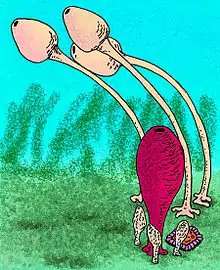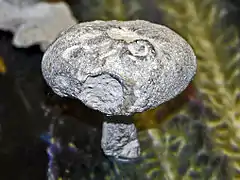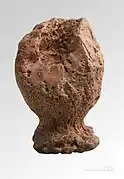Siphonia
Siphonia is a genus of extinct hallirhoid demosponges of the Lower and Upper Cretaceous, from about 125 to 66 million years ago.[1] They lived in the Western Tethys Ocean, in what is now Europe.
| Siphonia | |
|---|---|
 | |
| S. pyriformis & S. tulipa | |
| Scientific classification | |
| Kingdom: | Animalia |
| Phylum: | Porifera |
| Class: | Demospongiae |
| Family: | †Siphoniidae |
| Genus: | †Siphonia Goldfuss, 1826 |
| Species | |
| |
Description
They all had distinctive pear-shaped bodies that were attached to the seafloor via a long stem. Their common name, "tulip sponges," refers to their suggestive shape, while the genus name refers to how the spongocoel (the main tube of the sponge body) runs almost the entire length of the sponge, as though it were almost a drinking straw.
Gallery
 Siphonia lycoperdites , on display at the Museo Civico di Storia Naturale di Milano
Siphonia lycoperdites , on display at the Museo Civico di Storia Naturale di Milano Siphonia pyriformis - Muséum de Toulouse (fr)
Siphonia pyriformis - Muséum de Toulouse (fr)
References
- Parker, Steve. Dinosaurus: the complete guide to dinosaurs. Firefly Books Inc, 2003. Pg. 34
External links
Reconstruction of S. pyriformis
Reconstruction of S. tulipa, S. pyriformis, and the related Hallirhoa costata
This article is issued from Wikipedia. The text is licensed under Creative Commons - Attribution - Sharealike. Additional terms may apply for the media files.